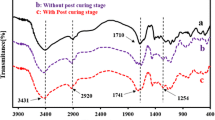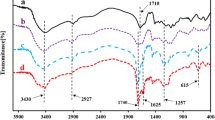Abstract
A series of highly crosslinked microgels has been prepared at room temperature via photoinitiated polymerisation in dilute solution using methyl methacrylate (MMA) and ethylene dimethacrylate (EDMA), respectively as non-functional monomer and crosslinker in N,N-dimethylformamide (DMF) as a solvent. The effect of monomer concentration and EDMA/MMA ratio on the yield, molecular weight and microgel size was studied and the data were compared to those previously obtained for microgels of similar composition prepared by thermal initiation. This mild polymerisation method yields better results compared to the more conventional thermal method, since it allows higher monomer concentrations to be employed as well as a better microgel size control. Consequently, the method can be advantageously used for the preparation of highly crosslinked microgels with improved properties, particularly useful, e.g. for molecular imprinting applications.

Similar content being viewed by others

References
Baker WO (1949) Microgel, a new macromolecule. Ind Eng Chem 41:511–520
Staudinger H, Husemann E (1935) Über hochpolymere Verbindungen, 116. Mitteil.: Über das begrenzt quellbare Poly-styrol. Chem Ber 68:1618–1634
Funke W, Okay O, Joos-Müller B (1998) For recent comprehensive reviews on microgels. Intramolecularly crosslinked macromolecules with globular structure. Adv Polym Sci 136:139–234
Saunders BR, Vincent B (1999) Microgel particles as model colloids: theory, properties and applications. Adv Colloid Interface Sci 80:1–25
Pelton RH (2000) Temperature-sensitive aqueous microgels. Adv Colloid Interface Sci 85:1–33
Saatweber D, Vogt-Birnbrich B (1996) Microgels in organic coating. Prog Org Coat 28:33–41
Luthra AK, Williams A (1995) Ester fission catalysed by microgels possessing hydroxamic acid groups: structure–reactivity studies. J Mol Catal A Chem 95:83–92
Otero C, Robledo L, Alcantara AR (1995) Study of the stabilization of pure lipases: comparison of two different lipase–microgel derivatives. J Mol Catal B Enzym 1:23–28
Ford WT, Lee J-J, Yu H, Ackerson BJ, Davis KA (1995) Cationic latexes as catalytic media. Macromol Symp 92:333–343
Ohkubo K, Funakoshi Y, Sagawa T (1996) Catalytic activity of a novel water-soluble cross-linked polymer imprinted by a transition-state analogue for the stereoselective hydrolysis of enantiomeric amino acid esters. Polymer 37:3993–3995
Kihara N, Kanno C, Fukutomi T (1997) Synthesis and properties of microgel bearing a mercapto group. J Polym Sci A 35:1443–1451
Schunicht C, Biffis A, Wulff G (2000) Microgel-supported oxaborolidines: novel catalysts for enantioselective reduction. Tetrahedron 56:1693–1699
Spanka C, Clapham B, Janda KD (2002) Preparation of new microgel polymers and their application as support in organic synthesis. J Org Chem 67:3045–3050
Shimomura O, Clapham B, Spanka C, Mahajan S, Janda KD (2002) Application of microgels as polymer supports for organic synthesis: preparation of a small phthalide library, a scavenger, and a borohydride reagent. J Comb Chem 4:436–441
Kwon YJ, James E, Shastri N, Frechet JMJ (2005) In vivo targeting of dendritic cells for activation of cellular immunity using vaccine carriers based on pH-responsive microparticles. Proc Natl Acad Sci USA 102:18264–18268
Das M, Mardyani S, Chan WCW, Kumacheva E (2006) Biofunctionalized pH-responsive microgels for cancer cell targeting: rational design. Adv Mater 18:80–83 references cited therein
Antonietti M, Gröhn F, Hartmann J, Bronstein L (1997) Nonclassical shapes of noble-metal colloids by synthesis in microgel nanoreactors. Angew Chem Int Ed 36:2080–2083
Biffis A, Orlandi N, Corain B (2003) Microgel-stabilised metal nanoclusters: size control by microgel nanomorphology. Adv Mater 15:1551–1555
Xu S, Zhang J, Paquet C, Lin Y, Kumacheva E (2003) From hybrid microgels to photonic crystals. Adv Funct Mater 13:468–472
Pich A, Hain J, Lu Y, Boyko V, Prots Y, Adler H-J (2005) Hybrid microgels with ZnS inclusions. Macromolecules 38:6610–6619
Lyon LA, Meng Z, Singh N, Sorrell CD, St. John A (2009) Thermoresponsive microgel-based materials. Chem Soc Rev 38:865–874
Nayak S, Lyon LA (2005) Soft nanotechnology with soft nanoparticles. Angew Chem Int Ed 44:7686–7708
Biffis A, Graham NB, Siedlaczek G, Stalberg S, Wulff G (2001) The synthesis, characterization and molecular recognition properties of imprinted microgels. Macromol Chem Phys 202:163–171
Maddock SC, Pasetto P, Resmini M (2004) Novel imprinted soluble microgels with hydrolytic catalytic activity. Chem Commun 53:6–537
Hunt CE, Pasetto P, Ansell RJ, Haupt K (2006) A fluorescence polarisation molecular imprint sorbent assay for 2, 4-D: a non-separation pseudo-immunoassay. Chem Commun 175:4–1756
Wulff G, Chong BO, Kolb U (2006) Soluble single-molecule nanogels of controlled structure as a matrix for efficient artificial enzymes. Angew Chem Int Ed 45:2955–2958
Chen Z, Hua Z, Wang J, Guan Y, Zhao M, Li Y (2007) Molecularly imprinted soluble nanogels as a peroxidase-like catalyst in the oxidation reaction of homovanilic acid under aqueous conditions. Appl Catal A Gen 328:252–258
Carboni D, Flavin K, Servant A, Gouverneur V, Resmini M (2008) The first example of molecularly imprinted nanogels with aldolase type I activity. Chem Eur J 14:7059–7065
Sellergren B (ed) (2001) Molecularly imprinted polymers. Elsevier, Amsterdam
Komiyama M, Takeuchi T, Mukawa T, Asanuma H (2003) Molecular imprinting from fundamentals to applications. Wiley, Weinheim
Barrett KEJ, Thomas HR (1975) Kinetics and mechanism of dispersion polymerization. In: Barrett KEJ (ed) Dispersion polymerization in organic media, chap 4. Wiley, London
Huang Y, Seitz U, Funke W (1985) Synthesis and characterization of bisacrylamide microgels containing sulfo groups. Makromol Chem 186:273–281
Ya HY, Row KH (2006) Characteristic and synthetic approach of molecularly imprinted polymer. Int J Mol Sci 7:155–178
Stalberg S (1997) Synthese uns Charakterisierung von geprägten Mikrogelen zur molekularen Erkennung von Zuckern. Diplomarbeit, University of Düsseldorf
Sun X, Chiu YY, Lee LJ (1997) Microgel formation in the free radical cross-linking copolymerization of methyl methacrylate (MMA) and ethylene glycol dimethacrylate (EGDMA). Ind Eng Chem Res 36:1343–1351
Chiu YY, Lee LJ (1995) Microgel formation in the free radical crosslinking polymerization of ethylene glycol dimethacrylate (EGDMA). I. Experimental. J Polym Sci A 33:257–267
Acknowledgments
Financial support from European Community through the Marie Curie RTN “NASCENT” (contract no. MRTN-CT-2006-033873) is most gratefully acknowledged.
Author information
Authors and Affiliations
Corresponding author
Rights and permissions
About this article
Cite this article
Dvorakova, G., Biffis, A. Room temperature preparation of highly crosslinked microgels. Polym. Bull. 64, 107–114 (2010). https://doi.org/10.1007/s00289-009-0134-z
Received:
Revised:
Accepted:
Published:
Issue Date:
DOI: https://doi.org/10.1007/s00289-009-0134-z



